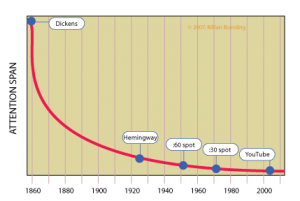Big gray blobs. What can we do about Text?
An art director who worked for us years ago used to call copy “those gray blobs that [foul] up my layouts.”
He was only half kidding.
As marketing evolves, we keep returning to the problem of text. How much of a brand narrative must be conveyed in words? What’s the proper ratio of verbal-to-visual that neither overloads or underperforms?
As always, we have the problem of the “short-attention spaniels” in this post-literate era. Your audience doesn’t (won’t, can’t) read. Because they’re not very good at it, that’s why.
Here are 7 more thought-starters. Discuss.
1. Your audience may need to read less than you imagine. Marketers tend to overuse text, anxious to provide “enough” information. Open a fashion magazine at random. The ad you’re staring at has a photo and a logo. Nuff said.
2. The words you say don’t count. The words you evoke matter.
3. Storytelling is a brand’s lifeblood. If your ad campaign lacks conflict or surprise or delight or silences or white space, it probably sucks as a story. Do over.
4, Visual storytelling allows the audience to participate more. This is the 25th birthday of “Just do it.” It’s a brand definition that explains nothing, is devoid of details, never gives us ten reasons why – instead, it allows us to finish the story our own individual way. We listeners call up our “yeah, well, I should lace ’em up and get back into shape” response, and the brand that admonished us becomes our coach.
5. Participation is engagement is trust is authenticity.
6. Go back and re-read #2.
7. Websites present a triple problem for a brand’s text decisions: there are quals, quants, and robots to satisfy, and they have three incompatible agendas. For SEO purposes, you need to feed the bots, but the two tribes of human readers respond very differently to those gray blobs of text.
Sorting out the delicate decisions presented by items 1 through 7 is what we help clients do. Want to talk?